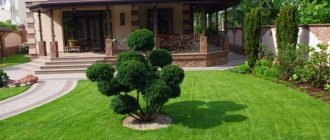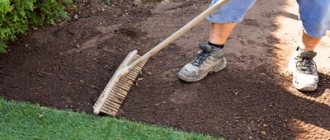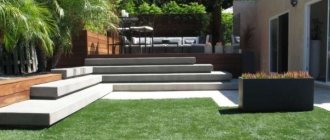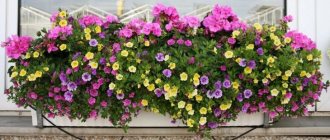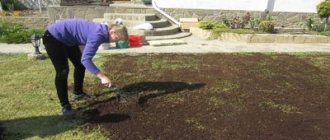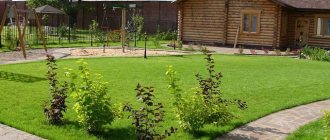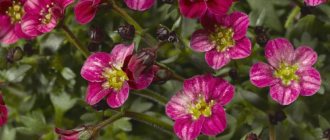The green lawn at the dacha can be used in different ways: to have picnics on it, to play sports, to organize a children's playground. But most often, a trimmed lawn is created as a decorative detail of the landscape. Single planted exclusive or simply beautiful plants, monoflowers, spruce, thuja and other coniferous vegetation look interesting on it.
Each situation places different stress on the grass, so it is important to choose the right grass or seed mixture for your lawn.
The best lawn grasses
To ensure that the green lawn does not require renewal for as long as possible, unpretentious types of grass with a long lifespan are used. Their development from germination to flowering is rather slow, but they remain viable for several years.
Top 10 best perennial lawn grasses:
- Sheep fescue (Festuca ovina L.) is a long-lasting grass with narrow leaves gathered into a dense bush. It grows back immediately after the snow melts, is not afraid of frequent and low mowing, and is highly drought-resistant and also resistant to trampling;
- Red fescue (Festuca rubea) is one of the unpretentious grass plants for the lawn. this type of fescue grows equally well on all types of soil, including poor rocky ones, and is resistant to difficult weather conditions (drought, low temperatures). Used for landscaping problem areas. The root system of the plant forms dense turf that is resistant to mechanical damage. Easily tolerates drought and severe frosts. Life expectancy up to 15 years;
- Meadow bluegrass (Poa pratensis L.) is a frost-resistant grass popular among landscape designers that grows quickly after winter. Numerous thin roots are highly branched, intertwine in the soil for a short time and form a dense elastic turf. Grows well in moist but not swampy areas. Although meadow bluegrass is not very picky regarding soil type, it does not respond well to high acidity;
- Meadow fescue (Festuca pratensis) - forms a powerful bush and, with proper care, remains viable for up to 15 years. Less resistant to trampling than red fescue;
- Common bentgrass (Agrostis capillaries) is a low grass with a thin stem and narrow leaves. Frost-resistant plant, grows on all types of soil, including salt marshes. To create a dense lawn, regular low mowing is recommended;
- Dog bentgrass, or velvet bentgrass (Agrostis canina) is a low-growing frost-resistant grass with rooting shoots. Forms low but dense grass stand. Not afraid of wet areas;
- White bentgrass (Agrostis alba) is a cereal plant that forms a uniform, dense grass stand. Can tolerate flooding during spring floods, afraid of drought. The roots, intertwined in the soil, form a strong, elastic turf;
- Bentgrass (Agrostis stolonifera) - grows well on loam and sandy loam with a high rate of air permeability. Since the root system is superficial, the plant does not respond well to drought. The advantage is the creeping shoots, due to the rapid growth of which the growth of weeds is suppressed.
- Perennial ryegrass, or perennial ryegrass (Lolium perenne L.) is a fast-growing meadow grass that forms a dense dense cover already in the first year of life. Viability is a little over 5 years. Does not develop well in dry, swampy areas and heavy clay soils;
- Beckmania eruciformis is a winter-hardy grass that tolerates flooding well. Powerful roots contribute to the formation of strong turf. The grass is resistant to trampling and grows back quickly after mowing.
Current prices for your city:
Types of grass mixtures
By selecting various plants and combining them in different proportions, producers obtain herbal mixtures with one or another feature.
Here are the most common types of grass mixtures:
- fast . They develop in the shortest possible time. This is important when restoring damaged areas of the lawn, which is why quick grass mixtures are often used as repair ones. Their main components are usually meadow bluegrass, meadow timothy or meadow fescue. The disadvantage of fast grasses is that they are short-lived, that is, they live relatively short lives. Perennial grasses grow slowly. By mixing both types, they achieve mutual compensation for shortcomings;
- shadow . Such mixtures specialize in poorly lit areas. The main component can be bluegrass, perennial ryegrass or red fescue;
- solar _ They love light and can stay in the open sun all day long. They also tolerate drought well. Representatives: meadow bluegrass, hop alfalfa, sheep fescue;
- universal . This mixture develops and forms a full-fledged healthy lawn in a wide range of conditions, so it is suitable for almost any site. The basis is often bentgrass, which successfully withstands severe frost, heat and prolonged drought. The peculiarity of this grass is its slow regrowth after cutting.
Annual herbs
Since the lawn is not created for one year, annual grasses are practically not used in it. The exception is temporary lawns. For example, it is planned to create a flower garden on the site, but not now, but in a year or two. In this situation, it is advantageous to sow the land with annual or biennial cereals or herbs: an unimproved piece of land will not spoil the landscape, and in due time the soil will be easy to cultivate, since annual plants will not create turf.
There are not many annual grasses for lawns, perhaps due to the fact that they are not in great demand. Most often, only two types are used in landscaping, ryegrass and bluegrass.
Lifehacks for sowing
To obtain the same density of turf over the entire area, the seed must be sown crosswise, passing in two directions. In the first pass, half of the seed is sown. You need to scatter it into the ground without any bald spots. The remaining part of the seeds is sown into the soil in the second pass, which is carried out according to the algorithm of the first.
Good adhesion of seeds to the soil can be ensured by spraying it with water from a fine spray nozzle. It is strictly forbidden to water the lawn after sowing with water from a hose without a sprayer.
What kind of lawn would you like to grow on your property?
MonoherbsHerb mixture
Before sowing grass, it is necessary to check the expiration date of the seed. You should not use seeds with a shelf life of more than 2 years for planting a lawn.
You can ensure a higher percentage of grass germination by using covering material or mulching the soil. In the first case, crops are covered with agrofibre if the air temperature during planting is below 15 degrees or there are many birds in the planting area. Mulching the soil is done when planting lawn grass in sandy or peat soil.
When and how to sow seeds
Lawn sowing can be done from early spring to September. In spring, this is done from April, when the earth warms up under the sun and the moisture has not yet evaporated. In a humid environment, the seeds quickly swell and begin to germinate. Seeds sown no later than the second ten days of September have time to germinate before the onset of cold weather, and young shoots take root even before the first frost. The root system of plants endures winter with virtually no loss.
You can also sow in the summer, but for this you should choose favorable conditions: in cloudy weather, after rain. To prevent young seedlings from drying out, you need to water the soil all the time until the grass comes into force.
How to seed a lawn:
- Calculate the seed rate for the entire lawn and measure the required amount of seed;
- Divide all the land allocated for the lawn into small, equal-sized plots; Depending on the area, there can be 2, 4, 6 or more (it’s more convenient when you get an even number);
- The mass of seeds is also divided into equal parts according to the number of plots;
- Sow each area with one portion of seeds, scattering them evenly by hand;
- You should move from the sown part in the direction of the not yet sown part.
A few weeks before sowing, the soil is dug up, and a few days later it is leveled with a rake. Immediately after sowing, the soil is leveled again with a rake in order to lightly cover the seeds with soil.
For better contact of the seed with the soil, it is recommended to roll the area with a light roller. It will compact the top layer, and the seeds will begin to germinate faster.
Useful video on planting lawn mixtures:
Seed consumption
Seeds of different types of lawn grasses differ in size and density, so seeding rates for specific crops vary. If we take the average parameters (seed size and its density), 30-40 g of seeds per 1 m2 are sown in light, loose soils, and 40-50 g/m2 in heavy soils. If the lawn has a large area, the mass of seed is calculated per 1 hundred square meters and is 3-4 kg on light soils and 4-5 kg on heavy soils.
A significant deviation from the norm in one direction or another is not desirable, as this affects the quality of the lawn. If you take more seeds, their germination is extended over time and occurs more slowly. The sprouts “compete” with each other: those that emerged earlier suppress the growth of late shoots. If less than the norm is sown, seedlings are sparse, uneven, and bald spots remain on the lawn.
Features of care
The main feature of a low-growing lawn is that it needs to be trimmed very rarely. This is done only 3-4 times per season, as it grows. The last haircut is carried out in the fall (September or October). Like any lawn, it will need frequent watering, which can be skipped during the rainy season. In this case, dividers or the sprinkling method should be used. In hot, sunny weather it is watered in the morning and evening. At first, the young shoots will have to be weeded, removing weeds. Then the lawn grass itself will displace them. You will need to sow seeds into the bald spots.
It is best to buy specialized fertilizers for lawns.
To make the lawn thicker, it is recommended to use mineral fertilizers. Nitrogen-containing substances are added in the spring, and potassium-phosphorus substances are added at the end of summer or autumn. If the grass begins to lose its brightness, then you can do another feeding. At the same time, for low-growing grasses, nitrogen must be strictly rationed and not overused, so as not to provoke rapid growth.
In the spring, you should rake away debris and aerate the soil. To do this, the ground is pierced with a pitchfork.
To grow a low-growing lawn, you can use different grasses for specific types of areas. There are low-growing varieties of lawn grasses. Caring for them is almost the same as for standard plant mixes, only cutting is done much less frequently. An interesting lazy option is the Moorish lawn, which is similar to a wildflower lawn and can be mowed just once a year.
Which herb to choose
Typically, seed stores sell ready-made lawn mixtures, and the crops included in them are selected for different growing conditions. Knowing where you plan to make a lawn, you need to buy a mixture that is suitable for the composition of the soil, corresponding to the degree of shading of the area, as well as soil moisture.
Lawn in the shade
Not all meadow grasses tolerate shade; it can be said that only a few lawn plants have the ability to withstand shade. This unique feature is inherent in the bluegrass. It grows well under tree canopies and in the shade of buildings. Even if very little sunlight falls on the lawn, the plant will cover all the bald spots and will not lose its rich color.
Important. Unfortunately, oak grove bluegrass is not resistant to trampling, so it is better not to walk on it. Also, in order to maintain the picturesqueness of the lawn, you will have to give up frequent mowing.
For important places
In low-lying places with constant humidity, the root system of plants becomes wet, and the lawn not only loses its decorative value, it simply dies. On such soil it is recommended to sow swamp bluegrass, which has powerful roots. The plant forms a lush green cover and grows back quickly after mowing. The disadvantage is the short lifespan, which is why you need to constantly sow seeds to maintain the decorative appearance of the lawn.
What is better for the lawn: grass mixture or monoculture?
Let's compare both options.
Monoculture
Advantage: the lawn looks uniform in color and structure.
Disadvantage: any negative factor that is unacceptable for this monoculture destroys the entire lawn. Typically, monoculture is used on lawns with high quality requirements and professional maintenance.
These are fields for playing bandy and football, tennis courts, etc. Also, parterre lawns are grown from one or two types of grass, the appearance and quality of which are also subject to high demands.
Grass mixture
It does not have such a uniform appearance as a monoculture, but it is more resistant to negative factors. This is explained by the fact that each factor that is unacceptable for one component of the mixture is easily tolerated by other components.
Thus, grass mixtures are recommended to be used:
- when creating lawns “with your own hands”, that is, amateur ones: it is more difficult for a non-professional to correctly assess all the features of the climate and soil, as well as accurately carry out the correct care;
- in problem areas.
The properties of the grass mixture and its resistance to certain negative factors depend not only on the composition, but also on the ratio of the components in it (proportions).
